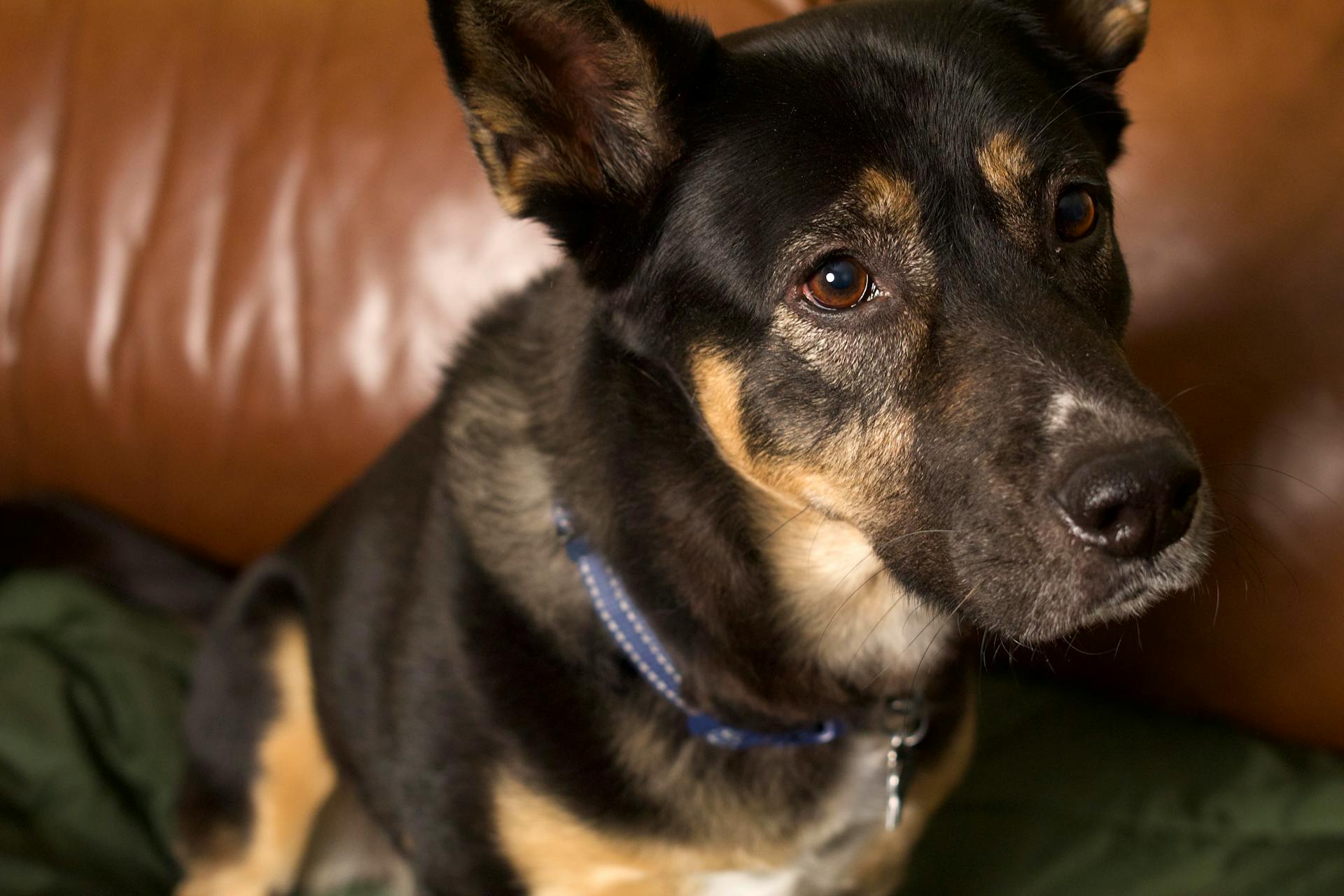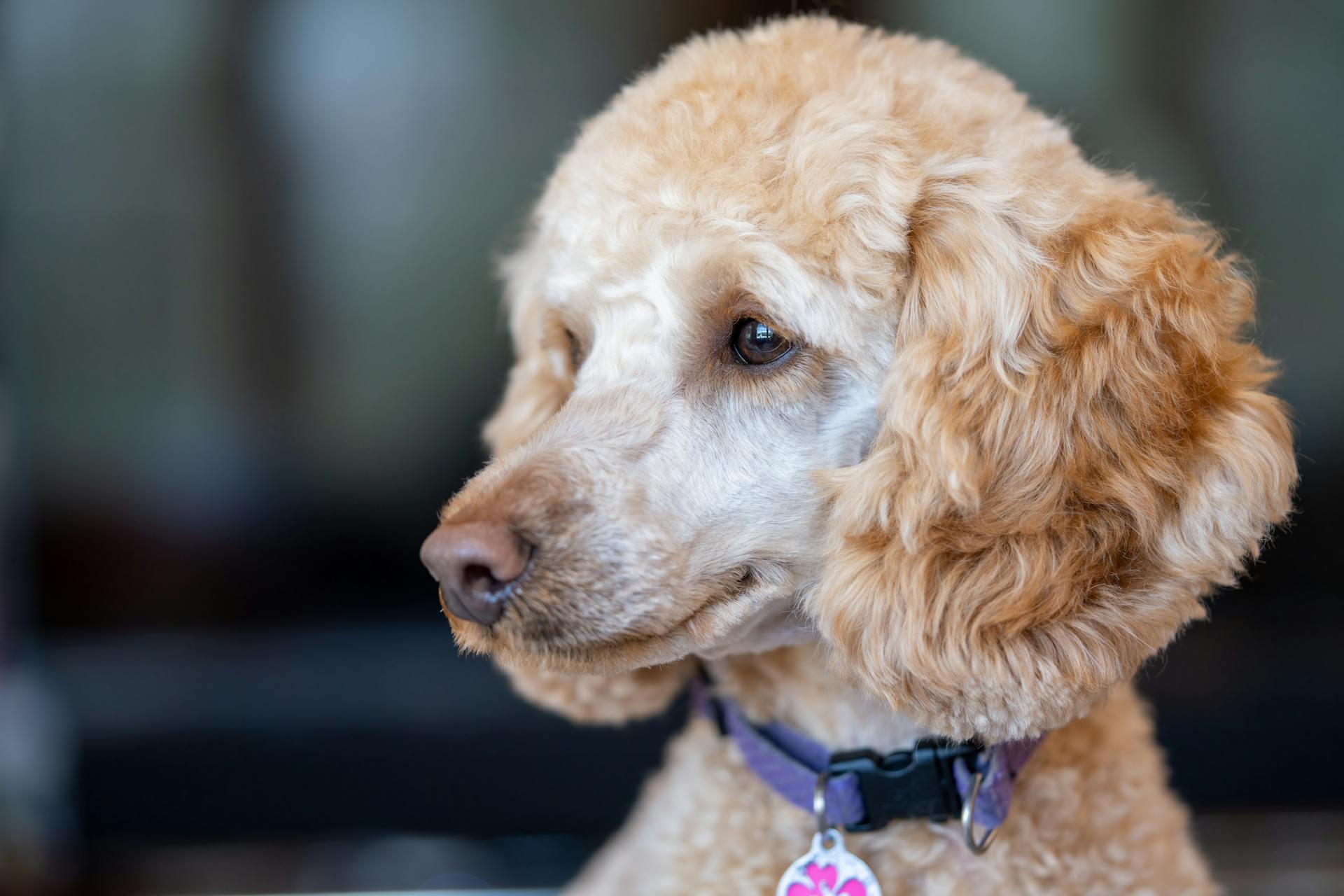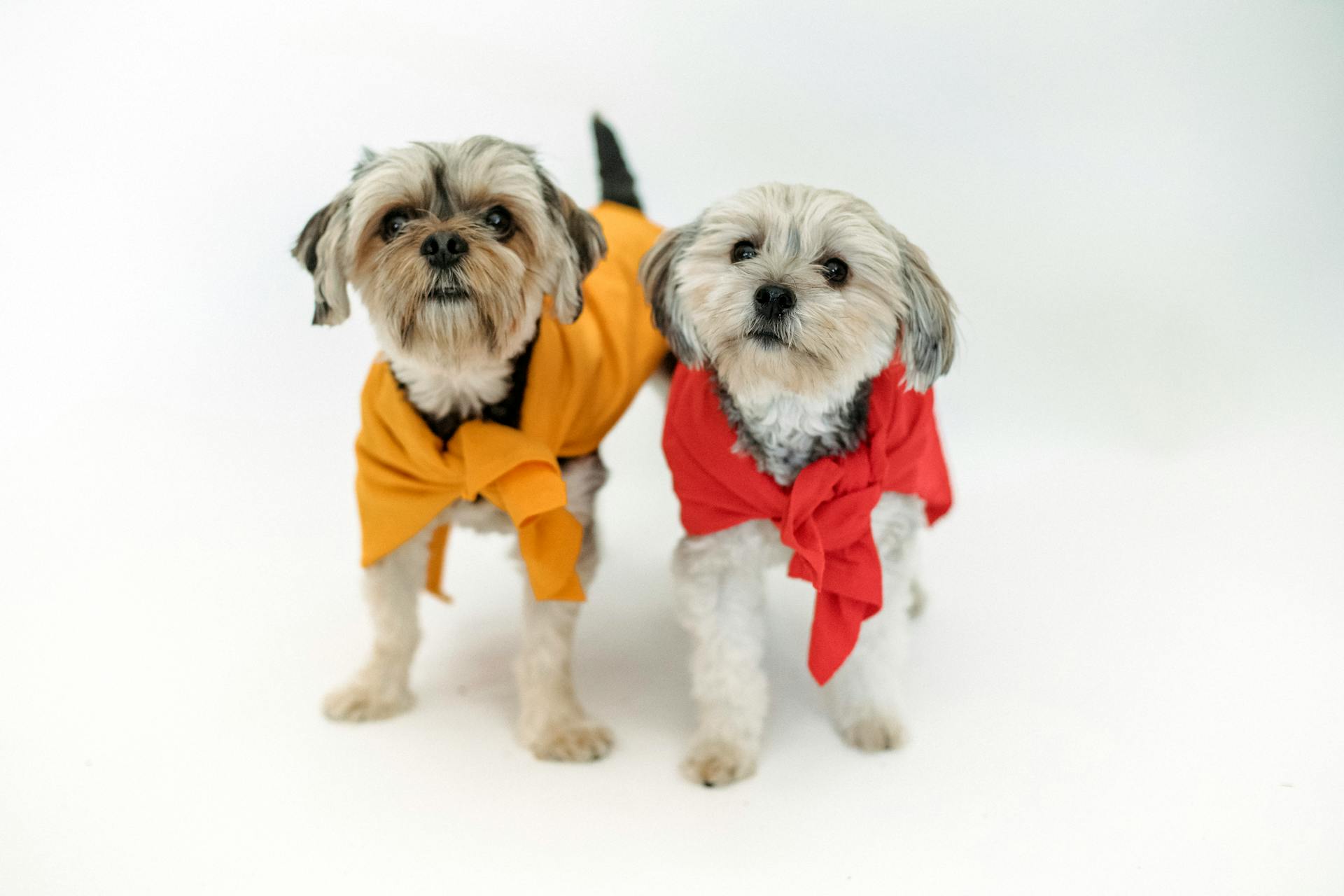
The Papillon dog mixed with Poodle is a unique and charming breed that's gaining popularity worldwide. This hybrid is a result of cross-breeding a Papillon with a Poodle, creating a dog that's intelligent, active, and affectionate.
The Papillon Poodle mix is often referred to as a "Designer Dog" due to its intentional breeding for desirable traits. They typically weigh between 7-15 pounds and stand between 10-18 inches tall.
These dogs have a low-shedding coat, making them a great choice for people with allergies. Their coat requires regular grooming to prevent matting and tangling.
Their intelligence and trainability make them a great breed for first-time dog owners, but they do require regular exercise and mental stimulation to prevent boredom and destructive behavior.
What is a Papillon dog mixed with a Poodle?
The Papillon dog mixed with a Poodle is a hybrid cross, also known as a Papipoo or Papi-Poo. They are obtained by crossing a miniature, toy, or standard Poodle with a Papillon.
Papipoos are known for their happy, smart, and loving nature. They have huge personalities despite being small dogs.
Both Poodles and Papillons are amongst some of the smartest purebreds in the world. This makes the Papipoo a very bright and easy-to-train companion.
The Papillon is a fun-sized dog that's super athletic and wildly curious. They have one of the most fabulous coats in the canine world and their butterfly ears are a distinctive feature.
Papillons are thought to be one of the oldest toy-sized dog breeds.
Physical Characteristics
The Papipoo is a delightful mix of the Papillon and Poodle breeds. They typically fall into the small to medium size range, with an average height of 10 to 12 inches at the shoulder.
Their weight ranges from 7 to 12 pounds, although there can be some variations due to genetic diversity within the breed. Papipoos often have a sturdy build despite their small size.
Suggestion: Male Poodle Dog
Their distinctive feature is their ears, which can be either floppy like Poodles or upright like Papillons, often with a butterfly-like shape. Some Papipoos may inherit the less common pendant ears, also known as "drop ears".
Their coat is a mix of characteristics from both parent breeds, often curly or wavy like Poodles, and can come in a variety of colors including white, black, brown, or a combination of these shades.
Here are the average physical characteristics of a Papipoo:
As a Papipoo grows, you can expect them to reach their full height between 7.5 to 11 months old.
Coat & Hypoallergenic Level
Papipoos have medium to long coats with a fluffy, shaggy feel to them. Their coat texture can range from curly to wavy to straight, depending on their genetic makeup.
Curly-coated Papipoos inherit their thick and textured curls from the Poodle, making them the most hypoallergenic of the bunch. Curly-haired Papipoos are a great choice for people with allergies.
Wavy-coated Papipoos are relatively easy to care for and aren't heavy shedders. Regular grooming is still essential to prevent matting and remove loose hair from their coat.
Straight-coated Papipoos take after their Papillon parents, but their hair tends to be a bit shaggier and more textured. They might be the least suitable companions for people suffering from allergies.
Here's a breakdown of the different coat types and their characteristics:
Papipoos are single-coated breeds, which means they won't inherit a shedding undercoat. This is a big plus for people with allergies.
Personality and Temperament
Papillon-Poodle mixes are known to be extremely intelligent dogs, able to learn basic commands and tricks quickly.
Their keen minds and athletic desires also make them excellent choices for agility or rally coursework and competitions. They can understand a command within 5 repetitions.
These friendly dogs love making new friends but prefer cuddling with their owners. At the end of the day, they're clingy and will gladly spend every waking moment with their family.
They're very active and energetic, requiring daily exercise to prevent boredom. Giving them interactive toys and puzzle feeders can help keep their minds engaged and prevent destructive behavior.
Papillon-Poodle mixes are non-aggressive dogs and make excellent companions for families with children. They're great with other dogs and house pets if socialized from an early age.
However, they can be prone to separation anxiety, so early training to develop their independence skills is vital. Crate training can also encourage them to feel comfortable with being alone for periods of time.
Their playful nature continues into adulthood, making them always ready for a game of fetch. They're eager to please and thrive on attention, making training a breeze with consistency and patience.
Health and Lifespan
Papipoos are generally healthy dogs, but they can inherit some health problems from their Papillon and Toy Poodle parents.
Their average lifespan is between 12 and 15 years, which is relatively consistent with other small to medium-sized dog breeds.
Papipoos can be prone to joint problems like patellar luxation and elbow dysplasia, as well as eye diseases like progressive retinal atrophy.
They can also be at risk of collapsed trachea, thyroid issues, epilepsy, and dental diseases.
In addition to these health concerns, Papipoos can experience minor issues like allergies and sensitivities, ear infections, digestive problems, and skin or coat health problems.
Regular veterinary check-ups and a balanced diet can help mitigate these concerns and promote a long and healthy life for your Papipoo.
Cleaning their ears regularly, especially if they have floppy ears, can help prevent ear infections.
Feeding a high-quality and nutritionally balanced dog food can also support your Papipoo's health.
Providing regular exercise, socialization, and plenty of attention, affection, and care can improve their life quality and lifespan.
Papipoos can live up to 14 to 18 years with proper care and attention.
Regular vet visits are crucial to keep track of your Papipoo's health and catch any illnesses early on.
See what others are reading: Papillon Dog Ears
Care and Needs
Papillons are surprisingly low-maintenance when it comes to grooming, requiring only occasional brushing and bathing.
Brushing your papillon's coat once or twice a week is sufficient, paying special attention to her hind legs and undercarriage to prevent matting.
A monthly bath is usually all she'll need, but you should keep an eye on her nail length, especially her dewclaws, to prevent them from curling around and piercing her leg.
Regular dental care is crucial for papillons, as they can be highly susceptible to dental problems like periodontal disease. Brushing her teeth at least twice a week is ideal, but daily brushing is even better.
Positive reinforcement training works best for papillons, so be sure to bring plenty of treats, head pats, and praise to each training session.
Living Needs
Papillons are a great companion for just about any setting due to their compact, bright, and highly adaptable nature.
They are gentle and friendly enough to be good companions for seniors, and small enough to make apartment living a breeze.

As a small-boned dog, papillons can easily be hurt by children playing too rough, so it's essential to supervise puppy playtime and teach any small kiddo how to properly interact with pets.
Papillons have no idea how small they are, which means care must be taken to keep them from jumping from places that are too high.
They should also be watched carefully when around much larger animals, as papillons will not hesitate to play with dogs three times their size as if they were equals.
Papillons are surprisingly low-maintenance when it comes to grooming, with minimal shedding and a simple brushing routine.
Brushing them once or twice a week, paying special attention to their hind legs and undercarriage, is about all they'll require.
It's also essential to keep an eye on their nail length, especially their dewclaws, as they can curl around and pierce their leg.
Daily brushing is ideal for papillons, as they respond best to positive reinforcement training and can quickly pick up new cues and tricks.
What to Feed

When choosing a diet for your Papdoodle, the options can be overwhelming. You have the option of feeding dry food or kibble, canned or soft food, semi-moist food, or raw food.
Canned food can be a great option for fussy dogs that struggle with hard kibble, but it's essential to consider your Papdoodle's dental health. Papi-Poos are prone to dental issues, so feeding crunchy kibble or a raw food diet with raw meaty bones and long-lasting chews might be a better choice.
It's crucial to consult your vet about feeding the right diet to your Papdoodle, as they can provide personalized recommendations. Any food changes you make should be done slowly to prevent digestive issues.
Papi-Poos are prone to weight gain, so practicing portion control and feeding an optimum quantity based on your pet's age and activity level is vital.
Grooming and Training
Grooming a Papipoo is relatively low-maintenance, but it does require regular attention to their nails, ears, and teeth.
To prevent ingrown or overgrown nails, trim them weekly. This will prevent discomfort and pain when walking.
Cleaning your Papipoo's ears once a week with a dog ear cleaner will prevent ear infections.
Brushing your Papipoo's teeth at least a few times a week, ideally daily, will prevent dental problems. Use dog-safe toothpaste and a dog toothbrush.
Papoodles generally require regular grooming based on their coat type. They can be bathed once a month and don't need professional haircuts or trims.
However, they do need regular brushing to keep their coat free from mats and tangles. This is especially important if your Papipoo inherits the Papillon's fine coat.
Here are some essential grooming tasks to include in your Papipoo's routine:
- Trim nails weekly
- Clean ears weekly
- Brush teeth daily
Training your Papipoo is a breeze, especially if you use positive reinforcement and stay consistent and patient. They love learning new tricks and will thrive with praise and treats.
To ensure your Papipoo grows into a well-behaved adult, start obedience training, potty training, and crate training as soon as you bring them home. Set a daily schedule to help with this process. The sooner you start, the better.
Socializing your Papipoo with different people and other pets from a young age is crucial. This will help build their confidence and prevent anxiety in new situations. However, only socialize them with fully-vaccinated adult dogs in a controlled environment until they've received all their vaccinations.
You might enjoy: Adult Schnoodle
Popularity and Cost

The Papipoo has gained immense popularity in recent years, with many dog enthusiasts falling in love with their adorable appearance and affectionate nature.
Their popularity has led to a surge in demand, making it essential to approach the selection process responsibly and seek out reputable breeders who prioritize the health and well-being of their dogs.
Papipoos are not inexpensive, with prices ranging from $1500 to $3500 due to the elevated demand and relatively low supply.
As a responsible dog owner, it's crucial to factor in additional costs beyond the initial puppy price, including food, vet bills, pet insurance, and grooming, which can add up to $15,000 to $20,000 over the dog's lifetime.
Reputable breeders should be sought out to ensure proper socialization of puppies and health guarantees, making the selection process even more important.
Frequently Asked Questions
Do papipoos shed?
Papipoos are not heavy shedders, but they do require regular brushing to prevent tangling and matting.
Sources
- https://www.petguide.com/breeds/dog/papi-poo/
- https://doodledoods.com/papipoo-101/
- https://www.dailypaws.com/dogs-puppies/dog-breeds/papillon
- https://rockykanaka.com/the-papipoo-phenomenon-discover-the-irresistible-charm-of-the-papillon-poodle-mix/
- https://raggydogs.com.au/blog/%EF%BF%BCpapi-poo-complete-guide-to-the-papillon-cross-poodle-mix-breed/
Featured Images: pexels.com


